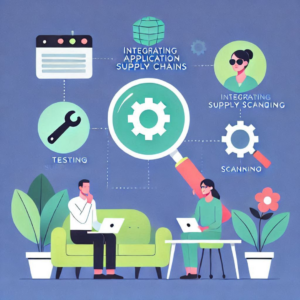Understanding DevSecOps and DevOps Software Testing in Application Supply Chains

DevSecOps refers to integrating development, security, and operations into the software development lifecycle. An application supply chain includes all stages of delivering software from development to production. This encompasses sourcing code, libraries, and dependencies, along with building, testing, and deploying applications. DevOps software testing plays a crucial role in ensuring each stage of this supply chain is secure and free from vulnerabilities. Each stage presents potential risks that attackers may exploit if not properly managed, so robust testing is essential to safeguard the entire process.
Integrating testing and scanning into the application supply chain serves multiple purposes:
- Quality Assurance: Ensures that software meets functional and non-functional requirements before deployment.
- Security: Identifies and mitigates vulnerabilities in the code and its dependencies.
- Compliance: Ensures adherence to regulatory standards and internal policies.
The Role of Automation in DevSecOps and DevOps Software Testing Supply Chain Integration
Automation is a key enabler in integrating DevSecOps into application supply chains. By automating testing and scanning processes, organizations can achieve faster feedback loops, reduce human error, and enhance overall efficiency. Tools such as Continuous Integration/Continuous Deployment (CI/CD) pipelines facilitate this automation by integrating various stages of the supply chain into a cohesive workflow.
Continuous Integration and Continuous Deployment (CI/CD) in DevOps Software Testing
CI/CD pipelines automate the process of integrating code changes, running tests, and deploying applications. This approach allows teams to detect issues early in the development cycle, reducing costs and efforts required to address them later. Key components of a CI/CD pipeline include:
- Source Control Management (SCM): Tools like Git enable version control and collaboration.
- Build Automation: Tools such as Jenkins, GitLab CI, and CircleCI automate the build process, ensuring code is compiled and packaged correctly.
- Automated Testing: Unit tests, integration tests, and end-to-end tests can be automatically executed as part of the pipeline.
- Deployment Automation: Tools like Kubernetes and Helm facilitate the deployment of applications to various environments.
Testing Strategies in DevSecOps and DevOps Software Testing for Application Supply Chains
Testing is a crucial aspect of the application supply chain. It ensures that software behaves as expected and is free from defects. Various testing strategies can be employed, including:
- Unit Testing: Validates individual components of the application in isolation and is typically automated.
- Integration Testing: Ensures that different components of the application work together as intended.
- Functional Testing: Validates the application against its functional requirements, including user acceptance testing (UAT).
- Performance Testing: Assesses the application’s responsiveness, stability, and scalability under load.
- Security Testing: Identifies vulnerabilities and security flaws, including static application security testing (SAST) and dynamic application security testing (DAST).
Implementing Testing in CI/CD Pipelines
Integrating testing into CI/CD pipelines is essential for achieving rapid and reliable software delivery. Here are some best practices for implementing testing in CI/CD:
- Shift Left Testing: Incorporate testing early in the development process to identify and address issues sooner.
- Automate Tests: Use automated testing frameworks to ensure consistent and repeatable testing processes.
- Run Tests in Parallel: Execute tests concurrently to reduce overall testing time and speed up feedback loops.
- Monitor Test Results: Continuously monitor and analyze test results to identify trends and areas for improvement.
Scanning for Vulnerabilities in DevSecOps
In addition to testing, scanning for vulnerabilities is a critical component of securing the application supply chain within a DevSecOps framework. Vulnerability scanning tools help identify known vulnerabilities in code, libraries, and dependencies. This process can be categorized into two main types:
- Static Application Security Testing (SAST): Analyzes source code or binaries for vulnerabilities without executing the program.
- Dynamic Application Security Testing (DAST): Test the application in its running state to identify vulnerabilities that could be exploited during runtime.
Tools for Vulnerability Scanning in DevSecOps
Several tools are available for vulnerability scanning, each with its strengths and use cases. Some popular options include:
- Grype: An open-source vulnerability scanner for container images and filesystems, integrating with CI/CD pipelines for real-time assessments.
- Snyk: A developer-friendly tool that scans for vulnerabilities in open-source libraries and container images, providing actionable remediation advice.
- Trivy: A simple and comprehensive vulnerability scanner for containers and other artifacts, scanning images, filesystems, and Git repositories for known vulnerabilities.
Best Practices for Integrating DevSecOps Testing and Scanning
To effectively integrate testing and scanning into application supply chains, organizations should consider the following best practices:
- Establish a Security-First Culture: Foster a culture of security awareness among developers and stakeholders, encouraging secure coding and regular security training.
- Implement Continuous Monitoring: Continuously monitor applications and their dependencies for vulnerabilities, regularly updating libraries and dependencies.
- Use a Centralized Dashboard: Implement a centralized dashboard to track testing and scanning results, providing visibility into the security posture of applications.
- Automate Remediation: Where possible, automate the remediation of identified vulnerabilities, such as updating dependencies or applying patches.
- Conduct Regular Security Audits: Regularly audit the application supply chain to identify gaps in security and compliance, reviewing processes, tools, and configurations.
Conclusion
Integrating DevSecOps into application supply chains for testing and scanning is essential for ensuring the security, quality, and compliance of modern software applications. By leveraging automation, adopting best practices, and utilizing effective tools, organizations can create a robust and resilient application supply chain. This approach mitigates risks and accelerates delivery. As the software landscape continues to evolve, the importance of integrating DevSecOps into the development process will only grow. To learn more about how to achieve this, explore DevSecOps: How to Integrate Security into Your DevOps Pipeline.
For more information on how Cloudastra Technologies can assist with software services. Do you like to read more educational content? Read our blogs at Cloudastra Technologies or contact us for business enquiry at Cloudastra Contact Us.